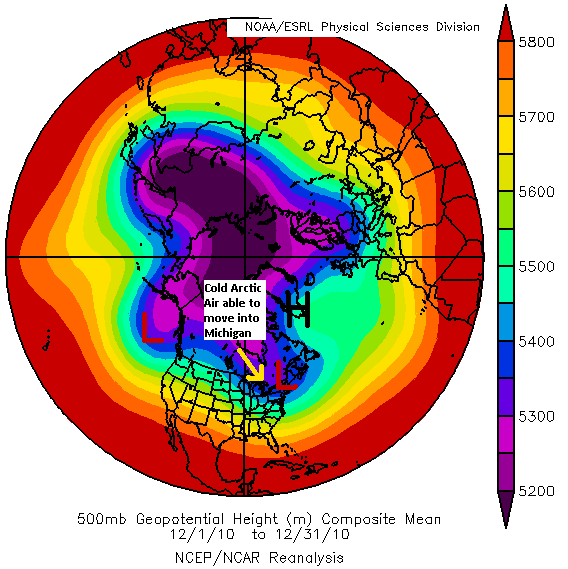A system that is currently over the northern plains will make its way into the Metro Detroit area on Sunday. This system will bring us mostly rain with some snow, but the bigger concern is the high winds and colder temperatures that will move in behind the cold front.
Currently, there are two areas of energy (aka…shortwave or upper-level lows) in the upper atmosphere, with the main feature over the northern plains and the secondary feature in Canada. These two shortwaves will combine together over the Great Lakes region causing the surface low to rapidly deepen. This will result in a fairly strong low pressure system that will move through northern Michigan bringing high winds and cold air behind it.
The first image below is a surface map for Sunday morning at 8am. The surface map is forecasting the center of the primary low (the red L) to be approaching the northern portion of Lake Michigan while the secondary low will be positioned near the Hudson Bay in Canada. Metro Detroit will be in the warm sector (south of the warm front and east of the cold front) with southerly winds bringing in warmer air. Because of this, the precipitation that we receive on Sunday will only be rain.
The above image is a forecast surface map for Sunday morning at 8am. This image is courtesy of HPC.
The second image below is a surface map for Sunday evening at 8pm. This surface map shows that the two low pressure centers combined into a single low pressure system. This is due to the two shortwaves combining in the upper atmosphere, and the result is a rapidly strengthening (deepening) system. The cold front will be well off to our east allowing cold air (e.g. cold air advection) to pour into our region thanks to strong west/northwest winds.
The above image is a forecast surface map for Sunday evening at 8pm. This image is courtesy of HPC.
When looking at surface maps, a sign that there will be strong winds is when you see the black lines (isobars) so close together. Isobars represent lines of equal pressure. Isobars become so close together when there is a large difference in pressure over a relatively short distance. The surface low just north of Michigan is forecasted to be quite low at 992mb, and if you look at eastern Montana, you will see a strong area of high pressure with the center forecasted to be at 1040mb. That is a difference of 48mb of pressure over a short distance! Now the atmosphere does all that it can to keep itself balanced or equal. With such a large difference in pressure, winds will blow much stronger in a direction from the high pressure towards the low pressure in an attempt to equalize the pressure. This is why we will have very strong winds tomorrow. Currently we are under a high wind watch. For us to have a high wind warning, sustained winds will have to be at least 40mph or higher, or wind gusts will have to reach 58mph or higher. I do not believe we will receive a high wind warning but we will most likely be under a wind advisory on Sunday with sustained winds around 25-30mph with wind gusts possibly reaching 50mph. These strong winds will help rush in cold arctic air resulting in Monday and Tuesday only reaching the 20s for highs (Tuesday might only reach upper teens). This cold air won’t last very long as a upper ridge will move into our area bringing the temperatures back up near 30F on Wednesday. So unfortunately there could be some power outages on Sunday into Monday morning just in time for the January bowl games! Hopefully that doesn’t happen.
2011 Wettest Year in Detroit History
Finally, it is worth mentioning that 2011 will go down as the wettest year in Detroit history, breaking the old record that was set back in 1880. Breaking a record that has stood for 130 years is pretty impressive! The Detroit area received 47.70 inches of precipitation (3 tenths of an inch away from 4 feet) barely beating the 1880 record of 47.69 inches. Below are a few interesting points about the 2011 record.
-2011 47.70 inches of precipitation is 14.60 inches above the annual average of 33.09 inches
-2011 had the wettest autumn ever and the second wettest spring ever
-November 2011 was the wettest November ever (6 inches of rain)
-July 2011 was the second wettest July ever (7.66 inches of rain)
-April 2011 was the fourth wettest April ever (5.61 inches of rain)
-September 2011 was the fourth wettest September ever (6.28 inches of rain)
Chris






